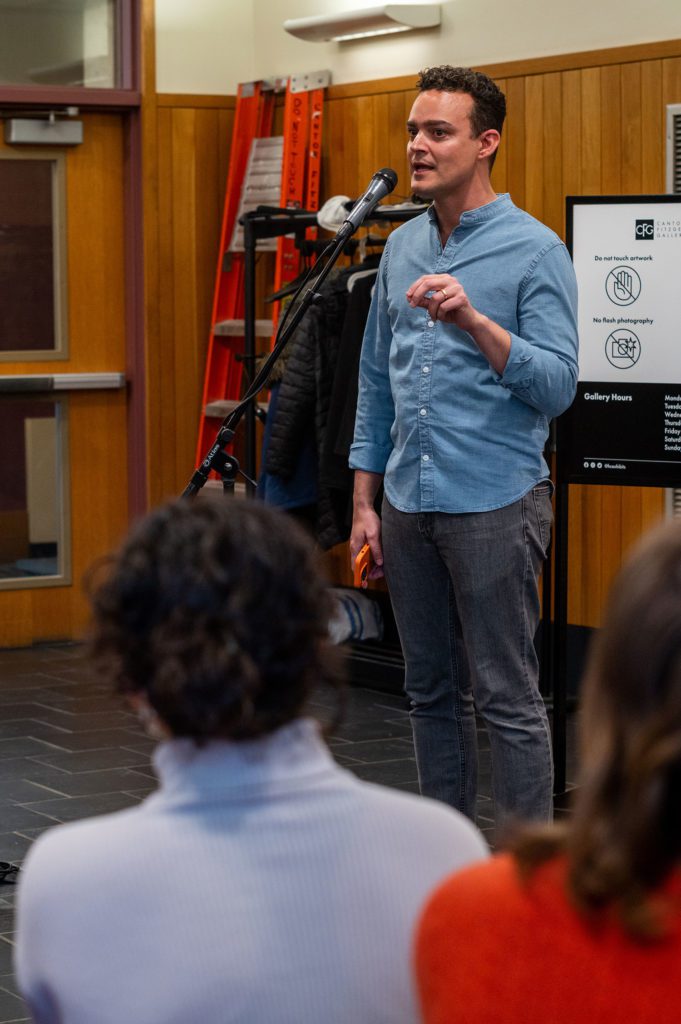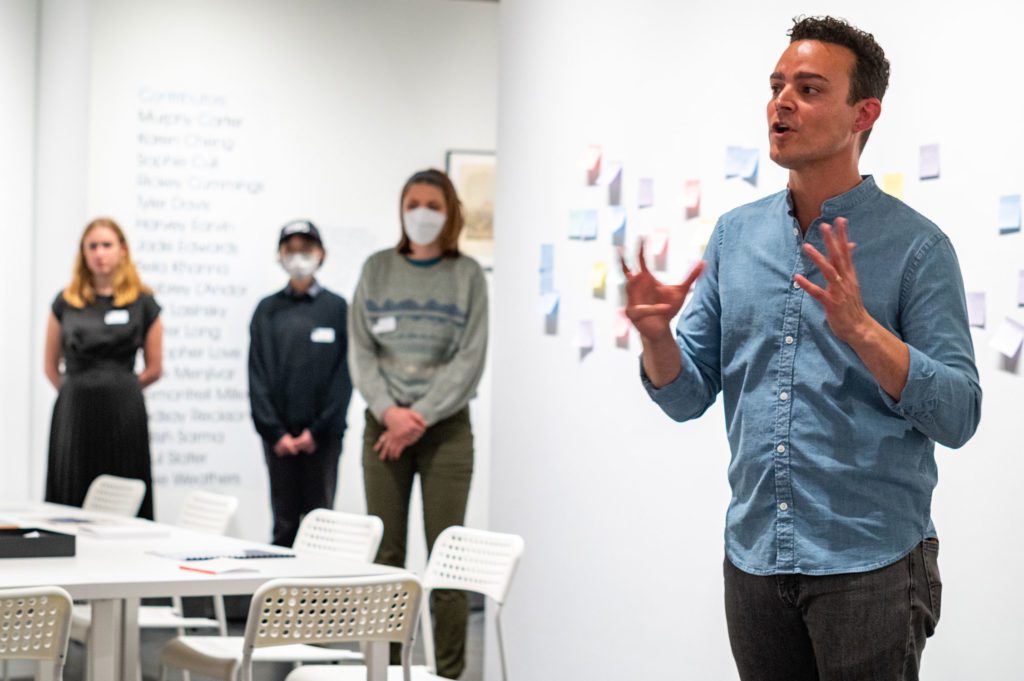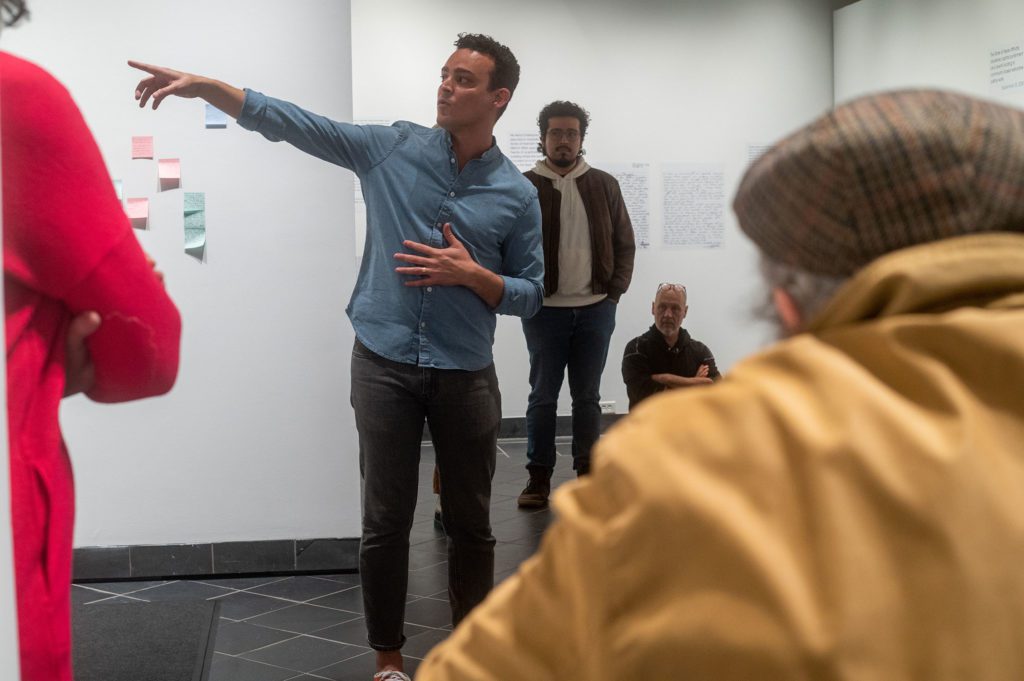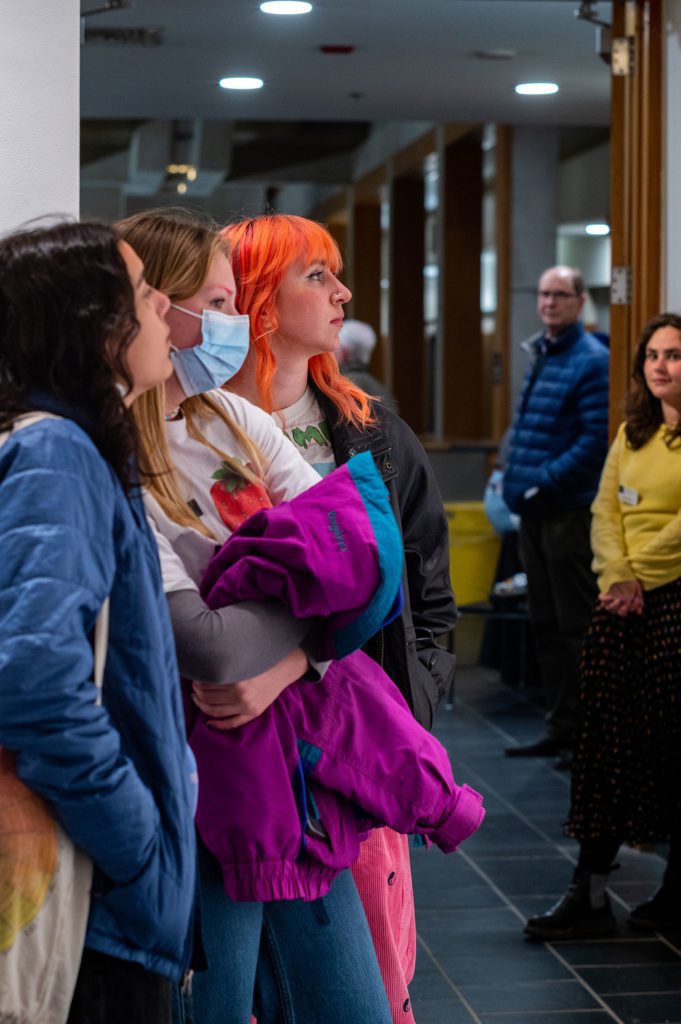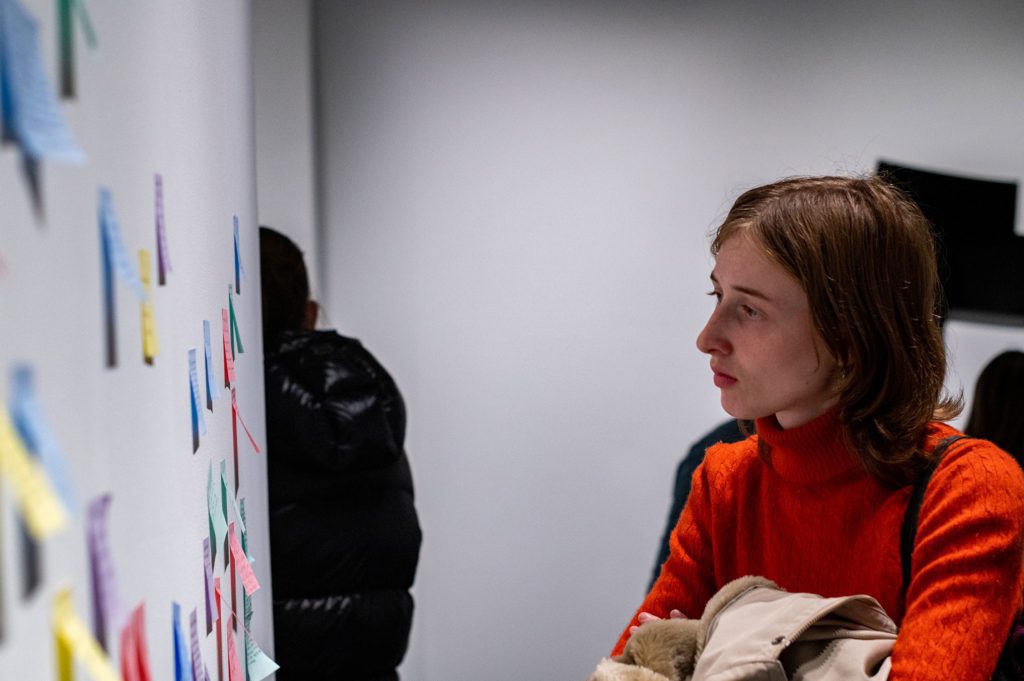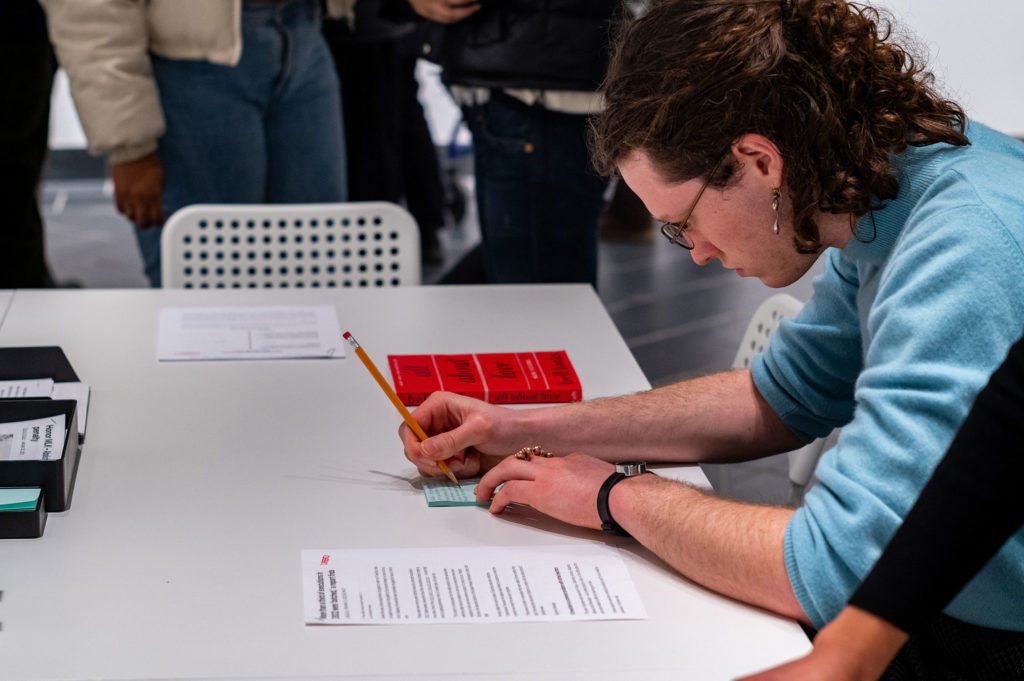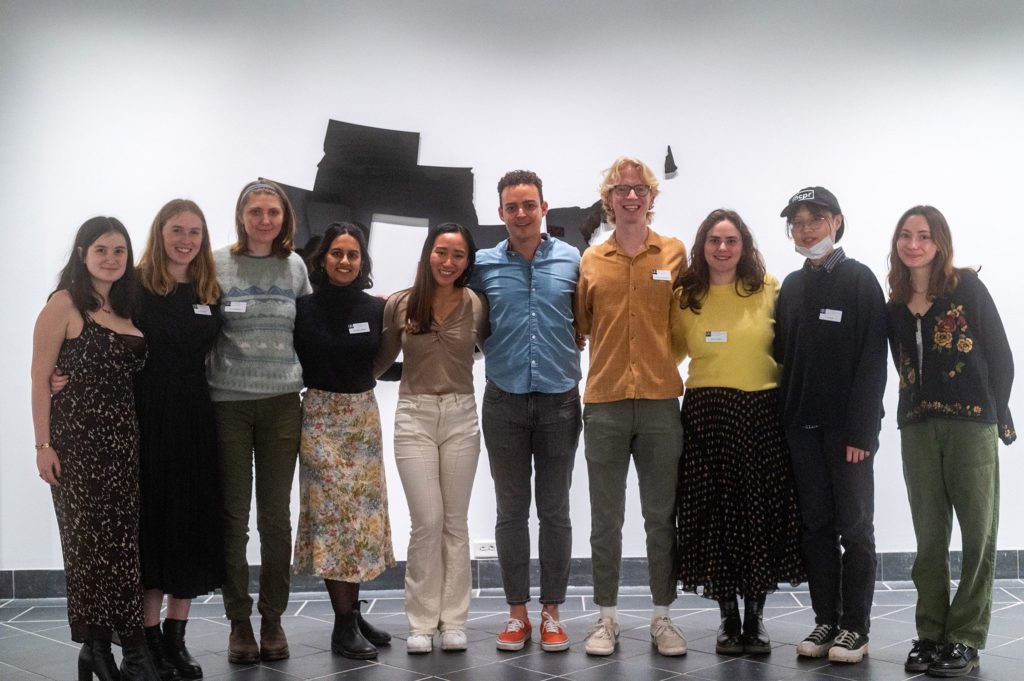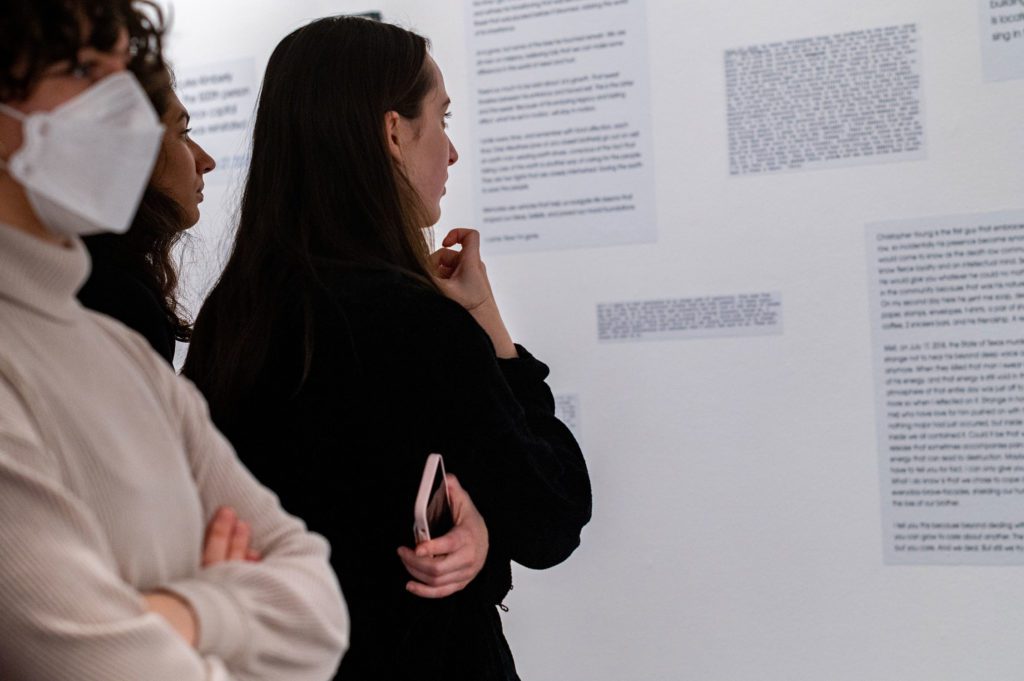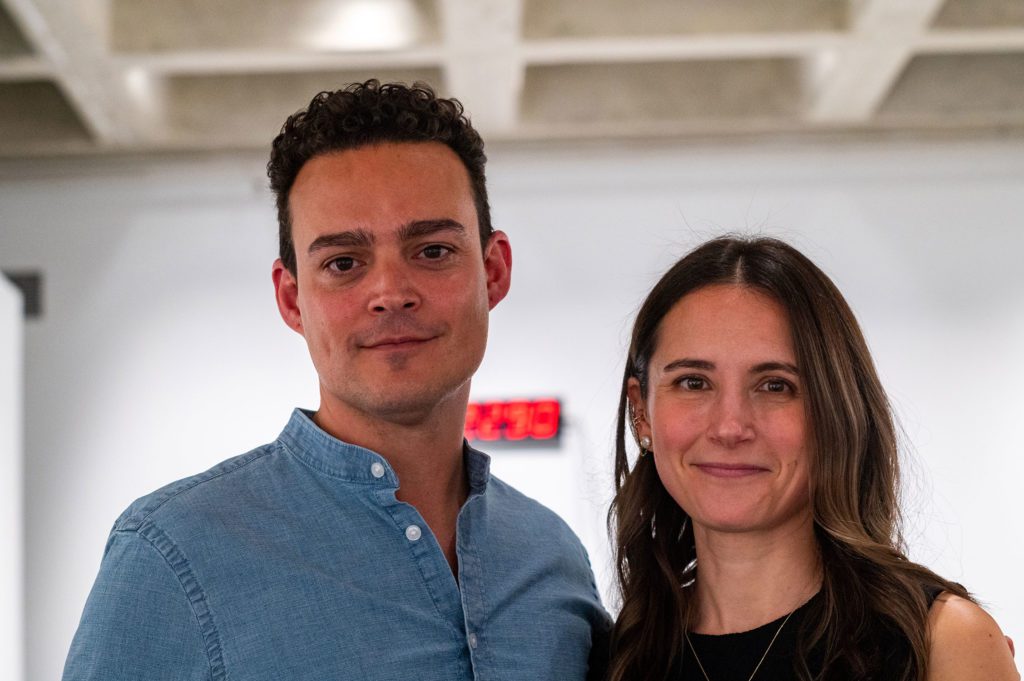In 2013, Texas executed the 500th person since capital punishment was instituted by the state in 1976. That was the moment that moved artist Mark Menjívar, a San Antonio native, to connect with people living on death row. Through personal accounts, research, and artistic expression, he organized Currently to start a conversation about capital punishment with the larger Haverford community. The exhibition, which opened on January 20 in the Cantor Fitzgerald Gallery as part of the Hurford Center’s Imagining Abolitionist Futures series, will be on view through March 3.
Each installation in Currently assesses capital punishment and its impact on individuals and their families, from macro and micro perspectives. “The United States, 2022,” for example, features a map of the 27 states that currently have prisoners on death row. Next to the map is a 2022 letter written by Oregon Governor Kate Brown, which commuted the death sentences of 17 people on death row and gave them life sentences instead. In the “I Wait and Watch for the Goldfinches, 2021” installation, an atomic clock ticks loudly to highlight how vital and slow time can feel when it dictates one’s freedom.
On the left wall of the gallery is an LED sign with red numbers, similar to one Menjívar kept on the wall of his studio at home during the height of the pandemic. That sign, updated daily, served as a constant reminder of the number of people living on death row in Texas. For the “Currently” installation, Menjívar expanded the project to tally the number of all those living on death row in the United States. The LED sign first appeared at Haverford in VCAM as its own mini-exhibition last semester.
Inconsistency in reporting by the states made calculating an accurate estimate difficult. “All of a sudden, numbers would change and drop three or four times, and that would mean we’d start digging even more into news stories,” said Menjívar. “Sometimes I’m getting on the phone and calling states and finding out who are the people who are maintaining those numbers and what are the stories behind them.” Thankfully, a research group of Bi-Co students helped him maintain the sign, which at this writing sits at around 2,300. The group includes Jillian Aguilar, Logan Zurita McKinnon, Ilani Lark, Hunter Logan, Kasey Ingerson, Abigail Clark, and Amelia LaMotte.
Also part of the exhibition is a large white table with paper, pencils, and resources related to incarceration, capital punishment, and love. A wall of sticky notes behind the table invites participants to write down ideas, ask questions, and imagine together a world without state-sanctioned violence.
In the back of the gallery space, “An Incomplete and Expanded Timeline of Capital Punishment in the United States” displays a curated history of capital punishment in America through various resources, including letters from individuals on death row today. Also included on the timeline are optimistic hopes about the further dismantling of the death penalty beyond 2023.
One of the collective hopes listed on the timeline has already come true. On Thursday, Feb. 16, Governor of Pennsylvania Josh Shapiro declared that he will not allow the state to execute inmates while he is in office, and called for state lawmakers to officially repeal the death penalty.
Some of the letters on the timeline were written by Rickey Cummings, a friend Menjívar has often communicated with and visited on death row.
“I was introduced to Rickey in 2016 through Gabe Solís, director of the Texas After Violence Project, who I am an artist-in-residence with,” Menjívar explained. “I had already been working with archives related to capital punishment for a couple of years, and Gabe suggested we get to know each other. We started writing regularly and our friendship has led to several long-term collaborations, including Currently. I now visit Rickey in person about every six weeks or so, and he is one of my closest friends. I’m so grateful for him.”
Menjívar includes personal accounts of his visits to Cummings on the timeline, as well as in other installations. “100 Quarters, 2023” depicts a bag of quarters totaling $25—the maximum amount of cash allowed to be brought in during death row visits. In another installation, “Full Circle, 2021,” Menjívar shares dashcam footage of his roundtrip from San Antonio to the facility in Livingston, Texas. Playing over the video is a reading from the book All About Love by bell hooks.
Currently was born from numerous collaborations between Menjívar, friends on death row, and students, faculty, and staff at Haverford. Associate Professor of English Lindsay Reckson and students from her fall 2022 course “Against Death: Opposing Capital Punishment in American Literature and Culture” helped Menjivar conduct research and organize materials for the exhibition.
“Collaborating with Professor Reckson on every aspect of this project has been so natural and meaningful,” said Menjívar. “It’s rare to find someone who brings together her depth of knowledge, aesthetic sensibilities, and compassion. She has also been working directly with Rickey and to see their relationship grow makes me so happy. It feels like we have been working together for years.”
Professor Reckson grew interested in the collaboration with Menjívar largely because of her close ties to Texas and Florida, two of the states that maintain the largest death rows in the country.
“The execution of Troy Davis in 2013 in Georgia was a turning point in my own activism and involvement in anti-death penalty work,” says Reckson. “Since 2014, I’ve been teaching a course at Haverford on the cultural history of capital punishment, which thinks about how art has the capacity to unsettle questions of justice and contest the power of the carceral state. Through that course, I’ve been lucky to work with some incredible community partners—including the Equal Justice Initiative, the Coalition to Abolish Death by Incarceration, Let’s Circle Up, and now Menjívar—and those collaborations have been central to the learning process, both for me and my students.”
Enabling student participation in the collaborative curatorial process opened up new opportunities to engage with art that centers on human rights issues and social justice activism. “This work continues to teach me that knowledge building …happens everywhere,” said Reckson. “It happens in the classroom. It also happens in prison visiting rooms, over JPay [a technology and financial services firm that has been called “the Apple of the prison system”], and in letters [to those incarcerated] that take too long to arrive. Centering the knowledge work and creative practice of incarcerated writers and artists is my ongoing goal, in the classroom and beyond. Also, my faith in art is continually renewed, and I think that’s an important thing to model in the classroom, especially in the most difficult political moments.”
Menjívar said he is thankful for the support of Reckson, Associate Director of the Cantor Fitzgerald Gallery and Campus Exhibitions Matthew Calinan, and William R. Kenan, Jr. Professor of English and Director of HCAH Gust Stadler, as well as the students who were part of the research group and gallery staff. The students appreciated Menjívar’s commitment to including several voices in the planning of the exhibition and representing people’s stories and experiences with care.
“I think a lot of the experience was learning how to make art that speaks out against extremely violent histories without reproducing any of that violence,” said Amelia LaMotte ‘25, who helped conduct research for the Currently installation and is working with Menjívar to create a website that delves into the people represented by the statistics. “I was really surprised at how emotional I was at the opening and at how moved I was walking through the gallery.”
Menjívar hopes that Currently helps expand people’s knowledge about capital punishment and inspires more active involvement in the political process at the local, state, and national levels.
“A great first step for anyone who is moved by the exhibition is to share what was meaningful to them with someone else,” he said. “This could be by bringing them to the exhibition or just talking about it. We so often don’t even talk about those living on death row and the ways state-sanctioned violence impacts individuals, families, and communities.”
On March 1, Menjívar will host a closing at the Founders Bell. The group will ring the bell 191 times: once for each of the 190 people thus far exonerated from death row, in celebration of their freedom, and once more as an appeal to abolitionist futures.
Additional support for the exhibition was been provided by Haverford College’s John B. Hurford ’60 Center for the Arts and Humanities, Office of the President, Office of the Provost, and the Haverford English Department.

